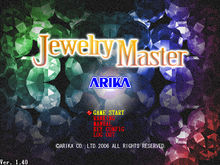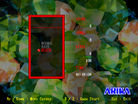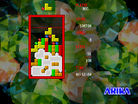Jewelry Master
| Jewelry Master | |
|---|---|
 | |
| Developer(s) | Arika |
| Publisher(s) | Arika |
| Platform(s) | Microsoft Windows |
| Release | 2006 |
| Gameplay info | |
| Next pieces | 1 |
| Playfield size | 9x17 |
| Hold piece | No |
| Hard drop | Yes, Sonic Drop |
| Rotation system | TGM rotation |
Jewelry Master was a non-Tetris game for Windows PCs which was released by Arika, known for its TGM series of games. While having different rules than Tetris, the game carried over many prominent gameplay features from TGM, such as IRS and 20G. This wiki entry is based on the beta release on November 24, 2006. The beta test was limited to 5000 participants, less than 1000 of which are currently taken. Jewelry Master was expected to release in December, and planned to be localised in English for Western markets.
Version Update
The November 24 version of the game, v1.07, was inaccessible as of November 30. A newer version, v1.10 was available for download on the same day. As of today, the game is unavailable for download.
How to Join the Beta
During its beta phase, the player could be part of the beta by following these steps:
Step 1: Downloading the Game
On the Jewelry Master website, the player downloaded 'JM.zip', linked with a green button at the bottom of the page. No installation was necessary; meaning they should simply extract the contents to a desired folder.
Step 2: Registering an Account
In order to actually play the game, the player needed to register for an account by enter their email address in the first box and their desired user ID in the second box on the registration page. An email was sent to their inbox containing their password. Players had 24 hours to log into the game before their account was deleted.
Step 3: Log In and Play
Players started JM.exe and enter their account information. This step had to be followed every time they play.
Gameplay Basics
The general idea was to combine gem colors to create diamonds which could be cleared in a large combo.
Segmented Pieces
- Main article: Tetromino#Multimino
Rather than always coming as a solid whole, pieces were often split into segments. While moving a piece, it behaved as a solid group, though once the piece locked, its segments would detach and fall if possible.
Lines
Lines must be composed entirely of blocks, not gems. Unlike Tetris, each piece segment that was part of the line entirely disappeared, even the bits that are not part of the line.
Enclosing the Gems
To enclose a gem, it must be completely surrounded in a section that was cut off from the top of the screen by any path. Enclosure allowed for diagonal holes, so players had to fence in the top, bottom, left, and right of the area the gems were located.
Combining Gems
Enclosing gems of different colors created a new color. Clearing primary colored gems (red, green, and blue) yielded the least points. Combining two of these created a secondary colored gem of either cyan, magenta, or yellow. Clearing these yielded more points than clearing primary gems. Enclosing all primary colored gems (by a combination of primary and/or secondary and/or diamond) created a white gem (diamond), which was worth the most points when cleared.
Clearing Gems
If the player enclosed gems and they were all of the same color, they cleared. In fact, this caused all gems of that color to clear even if they were outside the enclosure.
Game Modes
Jewelry Master featured 3 game modes. Unlike TGM, where the goal is usually a time attack to level 999, the goal was to score the most points.
Normal Mode
Pieces fell at speeds similar to TGM's Master Modes. Gems behaved as individual blocks.
Hard Mode
This mode played just like normal mode, except same-colored gems fused together to form a larger solid irregularly shaped gem.
Death Mode
The fastest mode, starting immediately at 20G. Gems fused together as in Hard Mode.
External links
- Official site (English)
- Official site (Japanese)
- Microsoft's AppLocale, to run the game in japanese locale and show text correctly
| |||||||||||||||||

